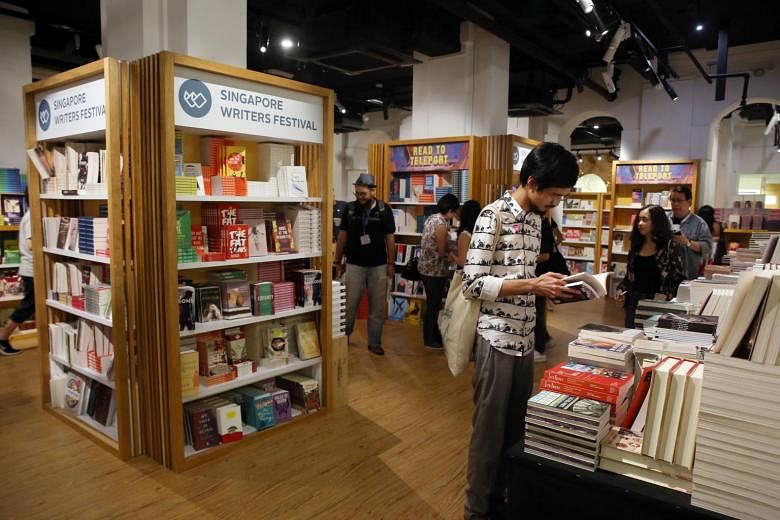SINGAPORE - For decades now, people have been sounding the death knell for physical books.
As a rookie books reporter in the 2000s, I covered the rise of e-books, along with the predictions of print on pulp going the way of the dodo.
Literary readership was in decline as digital entertainment held sway; and brick-and-mortar bookstores were closing one after another (this last, admittedly, a function of e-commerce and Amazon.com rather than declining demand).
But books - the kind you sniff when they're new and fall asleep with them spread open on your chest - have proved dastardly and stayed.
In this pandemic days, however, what might finally kill them is not demand but supply.
Last week, The New York Times reported how a printing shortage in the United States is seriously disrupting the publishing industry.
Two of the country's biggest printing companies - Quad and LSC Communications - are in financial trouble, with the former having to shut plants and put its book-printing arm up for sale, and the latter filing for bankruptcy.
Printing bottlenecks, as publishers rushed to put out this month's titles that were held back when the pandemic started, are causing delays in anticipated books and reprints of bestsellers reaching consumers.
Meanwhile, publishers who rely on overseas printers were left in the lurch when many Chinese printing plants shut down due to the Covid-19 crisis, and now grapple with logistics issues as global shipping continues to be patchy.
Add to this mess the distant prospect of paper shortage.
Two of the world's biggest paper producers are closing mills, citing declining demand partly owing to Covid-19. While the moves by Finland's UPM and Sweden's SCA are not expected to affect current global supply, it does take two million tonnes of publication paper out of the yearly equation, according to printing industry magazine Print 21.
All of which is to say: The spike in demand for physical books over the past decade is in danger of being scuppered by real-world constraints.
Hold on, while I charge my dusty Kindle.
As a reader - or even a writer with a traditional publisher - I did not often think very hard about those who ensured books rolled off the presses and became actual objects. But a new indie press venture has given me newfound appreciation and respect for the efficient, dedicated book printers in Singapore.
Throughout the circuit breaker period, I worked on a travelogue of New Orleans - a slim volume with text and pictures I wanted to put out on my own. It was therapy in a way: As travel bans and restrictions remained in force for much of the world's population, I focused on making sense of journeys past and what some places mean to me.
I decided to call my fledgling, one-woman-show imprint Hermit Press.
Author Julia Cameron's words from The Artist's Way reverberated in my head: Work with what we have rather than languish in complaints over what we have not.
I took book design courses conducted via Zoom by Venezuelean book designer Faride Mereb, a visiting scholar at Columbia University.
The pandemic and social distancing, ironically, meant that these courses organised by the Center For Book Arts in New York City was now open to anyone in the world, and my classmates included a photography student in North Carolina and an editor in La Paz, Bolivia.
I began e-mailing book printers here about a small print run for my tiny book. Working from home, they helped answer my amateur questions about types of paper, cover card stock, trim sizes and binding.
When the circuit breaker was partially lifted under phase one, the first person I left my home to see was Mr Ho Wah Yuen, boss of Ho Printing in Changi, who patiently walked me through its print-on-demand programme.
For a membership fee of $250, the PagetoPrint.com service allows self-publishers to upload their books' digital files and order any quantity to be printed. There are also delivery/distribution options and a virtual retail shopfront.
Without having to worry about minimum copies and keeping inventory, I decided to go with the printer. As a mostly self-taught designer, my digital files had some errors - images that were not in the right colour modes for the digital presses to handle; misaligned titles on the spines; mis-matched ISBN numbers. But the printer's customer service got in touch to alert me to fix them, an extra layer of checks that I was grateful for.
Last month, the first print run of New Orleans arrived on my doorstep. I stacked the 30 copies on my dining table and inhaled their woody, inky scent. In an uncertain world, it felt good to have made something and to hold it in my hands.
It may seem anachronistic to retrain as a publisher and book-designer in the 21st century. But with so many of us staying home these days, and having more time for creative pursuits, it makes perfect sense to revisit the notion of books as precious passion projects. Perhaps it is time to write that memoir you've been putting off or edit that poetry collection currently existing on scraps of paper.
And it will be technology - once the harbinger of print's demise - that would enable us to bring those projects to fruition.
Print is far from dead. But for it to stick around, we have to stop taking our local publishing and printing sectors for granted.
• New Orleans ($13.99) is available from BooksActuallyShop.com


